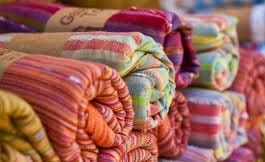Based on the recommendations made by the Duty Drawback Committee, the government has announced the revised duty drawback rates vide Customs Notification 07/2020-Cus (NT). The marginal increase in duty drawback across the textile value chain will come into effect from February 4, 2020. The Southern India Mills’ Association (SIMA) has hailed the announcement.
The government reimburses the customs duty and other central taxes that are not subsumed in the GST and levied on inputs used in the manufacture of exported final product by way of duty drawback. The Duty Drawback Committee periodically revises the drawback rates and the value cap (if any) depending upon the incidences of duties and taxes.
The duty drawback rate for cotton grey yarn has been increased from 1.7 per cent to 1.9 per cent, for fabric from 1.6 per cent to 2 per cent, made-ups from 2.6 per cent to 2.8 per cent, apparel from 1.9 per cent to 2.1 per cent, thus encouraging value addition and benefit the predominantly cotton based spinning sector.
Thanking the government for considering the inputs given by the textiles and clothing industry and enhancing the rates marginally across the value chain, SIMA chairman Ashwin Chandran said, “Duty Drawback being a WTO-compatible export benefit, the scheme would help the exporters to achieve a sustained growth rate provided the duty drawback calculation takes care of all incidences of duties and taxes.”
Stating that the marginal increase in duty drawback might help to boost cotton yarn exports to a certain extent, Chandran appealed to the government to remove the value cap for spandex yarn and certain categories of woven fabrics to encourage value addition.
“It is essential to refund the state and central levies that are not refunded under duty drawback calculations to make the cotton yarn and fabric exports competitive. The industry has been pleading the same from the inception of announcing Rebate of State Levies (RoSL) benefit for garments and made-ups,” said Chandran. He appealed to the Government to include cotton yarn and fabric under Rebate of State & Central Taxes and Levies Scheme (RoSCTL) to revive the spinning and weaving segments from the long drawn recession, utilise the surplus capacity, convert the surplus cotton into value added products and export and also create jobs for several lakhs of people.
He stated that the new Remission of Duties or Taxes on Export Product (RoDTEP) benefit would refund all the embedded / blocked duties and taxes and cover all the textile products viz fibres, yarn, fabrics, garments, made-ups, technical textiles, etc across the value chain to have a level playing field in the global market and remain competitive.
(The Notification No: 07/2020- Customs (NT) dated 28/01/2020 issued in this regard has already been forwarded to all members)

